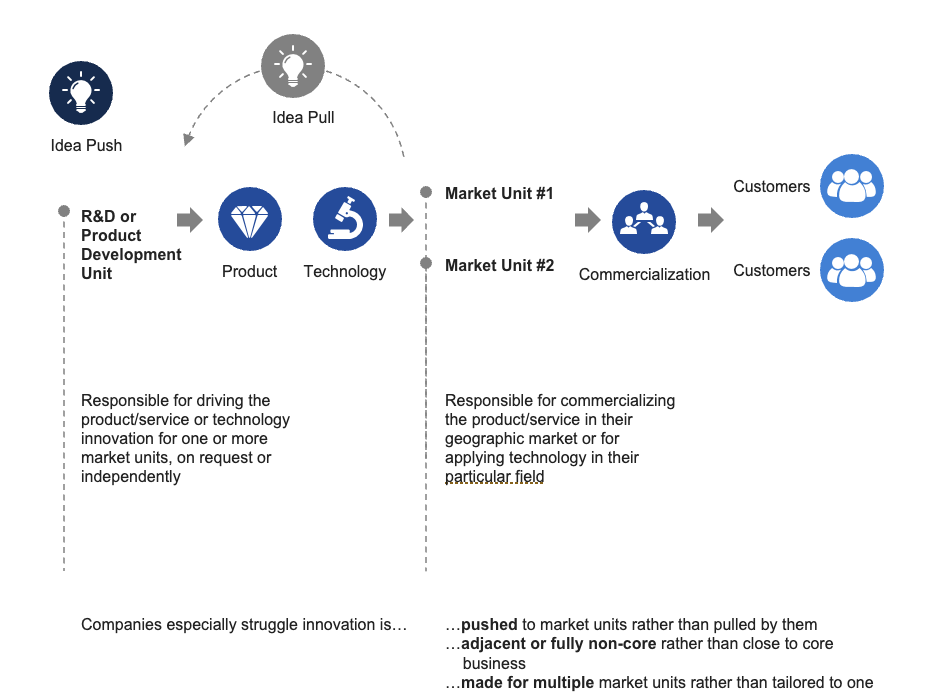Most mature companies and highly successful startups organize themselves by function and those functions could turn into silos. Innovation success is facing a common obstacle, which is usually the misalignment between product and customer-facing teams.
The misalignment starts from a discrepancy between each department due to lack of time and closeness to the client. As the organization’s sales force is the direct interface to the client, it receives direct feedback and can adjust their goals rapidly to meet the needs of the client. On the other hand, product innovation requires longer planning and orientation and that’s why concrete insight from sales is crucial to create innovations that will meet the needs of the client.
A recent research showed that about 30% of organizations experience inefficient collaboration between R&D/innovation and sales teams and it’s the biggest obstacle to higher innovation output.
Is there anything we can learn from organizations that are not yet in the spotlight, but drive innovation in their respective industries? Are they introducing new management techniques or simply putting tried and tested methods to new use in innovation practices? The following strategies have helped organizations bridge the gap between customer facing and innovation teams and can be easily adopted by companies that strive to improve their innovation processes.
Exhibit 1 – Lack of R&D Sales Collaboration is a Consistent Issue
.png)
Exhibit 2 – Most Large Companies Face R&D-Sales Disconnect
Two-way Feedback
Lack of training of the sales team on the best ways to share and store customer feedback, in addition to their limited visibility into the product team’s decision-making process, increases the likelihood of conflict.
Sales can feel like they are repeating the same thing constantly, and in some situations this can cause sales reps to augment the importance of a certain request or feedback, overestimating the number of times they’ve heard it. On top of that, they might overlook the underlying strategic objectives that are guiding the product team’s decisions.
As sales representatives work directly on the client front, they are a valuable source of ideas and feedback. Thus, they are able to keep an "ear in the market" into the innovation process in a structured way. This can only work if employees are willing to communicate efficiently and pass on ideas - even if only some of the ideas are implemented.
This requires going beyond the zero-defect culture, which is prevalent in manufacturing companies. It must be established that many ideas are needed to celebrate few successes.
That way, unrealistic expectations and employee demotivation can be prevented. This is not a new principle (especially for the sales department), as they are used to making several calls before closing a couple of sales.
To make a good contribution to the innovation process as a sales representative, information and ideas must be brought into a structured way and communicated accordingly. An idea is structured when it is clear for the person who wants to improve something, which trends and needs are going to be fulfilled and who is going to be benefited from it.
One-Team Mindset
Many innovation leaders place significant value on cross-functional teams. For example, some companies link strategy, product development and sales teams by creating smaller, end-to-end teams to create joint growth opportunities.
These teams are autonomous, but remain within the main business, and their members have a minimum viable set of cross-functional commercial, sales, and operations skills. They have access to specialized expertise, as needed, project by project. This approach has allowed companies to become leaders of certain solutions in emerging and high-potential markets, such as autonomous vehicles and shared mobility.
In fact, a few innovative organizations encourage flexible talent rotation across business units. Idea initiators can temporarily change their line of responsibilities and project-manage the development of their ideas. Employees have the option to choose spending three months in the company’s innovation lab, and validate an idea by building a minimum viable product.
A senior member from a relevant business unit guides their work, championing the project and making sure that emerging products find a place in the organization. This kind of rotation has become a desirable option for young talent to prove their leadership skills, and the organizations successfully establish a one-team mentality.
Other companies have adopted two important changes: shifting their central R&D budgets into the business and revamping their engineering’s team culture. Their engineers work in product development, but also participate in the sales launch to understand the deployment challenges that might come up. They get the opportunity to become their own customers, actively using their products. And they regularly switch job roles between R&D and business teams, as mentioned above.
Incentives and Metrics Alignment
| It’s obvious that incentives are crucial for a desired behavior, but it’s not common to come across organizations that incentivize innovation with consistency. Some companies use a practice called matching metrics to address both sides of the innovation process: R&D and client facing teams. Business unit members are incentivized on product vitality (the share of sales from products launched) while R&D leaders and engineers are incentivized on new sales generated by the patented products or technologies they develop. Both functions collaborate more effectively because these companies use complementary metrics to engage them. Introducing shared metrics is quite clear to implement, but it requires a robust accounting system to track innovation activities and results. |  |
Clear Communication, Directives, and Accountability
Effective innovation requires two essential components, which are accountability and clear communication. This insight reaches a great level of execution through a system of mirrored central and regional teams that matches team member roles one-to-one. This ensures direct exchange and accountability, as well as clear channels for feedback to the central team on localized customer needs.
To avoid complications, product managers’ performance is tracked centrally, starting from product development, through rollout. They establish a central launch support team to share insights and findings from more than one region and to make backup resources with experience available, as needed.
Other companies manage their middle to long-term innovation output via a shared roadmap that R&D and product owners jointly maintain. This is valuable for integrated services that leverage hardware and software solutions and are sold directly to end customers with subscription payment models. This type of innovation activities need a shared understanding of long-term customer requirements and do not rely on precise technical requirements from channel partners or B2B intermediaries.
Success Sharing
Typically, sales and R&D teams celebrate successes separately – the former when they hit targets, the latter when a significant new feature is released. But along the way, the work that each team does to benefit each other, remains unrecognized. By taking a more holistic view and recognize every team involved for their ideas and contribution, organization can achieve true innovation excellence.
Companies are finding different ways to shake things up and look at opportunities with a different perspective. Some companies leverage all the possibilities of a technology along the product life cycle by keeping the patent-holding R&D team members involved, as part of a technical steering committee. Besides facilitating the knowledge exchange, this arrangement acknowledges and celebrates the business contributions of engineers who develop cutting-edge ideas that change the way things are.
Finally, companies are also thinking in terms of customer value proposition, rather than technical requirements. Business teams empower R&D teams to create more original solutions to meet customer requirements. This change is often challenging for the involved members in the beginning, but once the new norm is embedded across the organization, it creates the necessary space for more disruptive products and business model innovation.
Get the Right Products to Market Faster
Sometimes product teams build features exactly as the user requested, but they end up undermined because the users themselves weren’t able to understand or explain their own needs when they made a certain feature request, or maybe they didn’t know that an alternative solution was out there.
Sales reps must know what the value chain looks like and for which specific client groups or buyer personas they want to build something. The more targeted, the better - according to the motto "If you target anybody - you target nobody".
However, the target audience should not be so specific that the product will be developed for a single client. Assuming the sales rep recognizes a client’s challenge and even has an idea for a solution, the next step should be to identify if other customers are also going to be benefited from this solution.
Key Takeaways
The past year was one in which many companies optimized their cross-functional team efforts, often while working remotely. But necessity created new processes that now must be implemented with the correct structure in order to stick. Sales reps can greatly contribute to the ideation process. It’s essential to adopt a structured method for integrating the sales team in the innovation process. Organizations can create and maintain successful innovations in many ways. Executives have enough tools at their disposal, such as tried-and-true organizational or governance measures and initiatives like incentive design, continuous relationship building, and change of culture. Although solutions for specific cases depend on where you start and industry, the examples described above showed that there are many paths towards collaborative innovation. |  |





